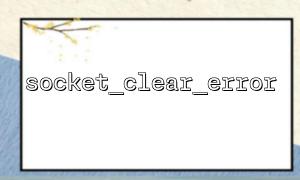When programming networks in PHP, especially in high concurrency environments, it is crucial to properly handle Socket errors. The socket_clear_error() function is a tool used to clear error states on Socket resources and is very useful for maintaining the stability of long connections and avoiding exception buildup. This article will explore how to effectively use socket_clear_error() in a high concurrency environment, and share some practical tips for performance optimization and exception handling.
socket_clear_error() is a function provided by the PHP Socket extension to clear error status on specified Socket resources. It is often used to reset the Socket state after an error is detected, thus avoiding subsequent operations due to old errors.
<?php
// ClearsocketError status on the resource
socket_clear_error($socket);
?>
It should be noted that this function does not close the Socket, but only clears the error mark so that the Socket can continue to be used.
A high concurrency environment means that the server handles a large number of Socket connections at the same time, which puts higher requirements on resource management and error handling:
Frequent error detection and cleaning : A large number of connections are prone to various exceptions and errors. Timely cleaning of error status can avoid the "backlog" of errors affecting performance.
Resource competition : When concurrently accessing the same Socket resource, error handling must be thread-safe to prevent state confusion.
Performance overhead : Frequent calls to error cleaning functions may bring additional system calls, affecting the overall throughput.
To avoid frequent calls to socket_clear_error() without discrimination, it should be combined with actual error detection logic:
<?php
$error = socket_last_error($socket);
if ($error !== SOCKET_EWOULDBLOCK && $error !== SOCKET_EAGAIN) {
// Non-non-blocking related errors,Clear错误状态
socket_clear_error($socket);
}
?>
This approach avoids meaningless cleaning of non-error states, thereby reducing system calls.
In high concurrency environments, error status often complements exception handling. It is recommended to use socket_last_error() to get the error code, and then decide whether to clean or try again based on the error type.
<?php
$error = socket_last_error($socket);
switch ($error) {
case SOCKET_ECONNRESET:
// Connection reset,Retry or close the process
socket_clear_error($socket);
break;
case SOCKET_EAGAIN:
// Resources are temporarily unavailable,Wait for a try again
break;
default:
// Other errors,Log and clean
socket_clear_error($socket);
break;
}
?>
Avoid calling socket_clear_error() in every loop or every request, you can use a counter or time threshold to control the call frequency:
<?php
$clearErrorCounter++;
if ($clearErrorCounter >= 100) {
socket_clear_error($socket);
$clearErrorCounter = 0;
}
?>
This method can reduce function call overhead while ensuring that the error state does not accumulate excessively.
In high concurrency environments, using non-blocking Sockets with event-driven models such as select() or epoll can significantly improve performance. The call to socket_clear_error() should be combined with the event loop to avoid blocking.
Avoid meaningless error cleaning calls. Only after detecting an error, call socket_clear_error() to reduce the number of system calls.
Reasonably design the connection pooling mechanism to avoid single Socket exceptions affecting the overall service. Be careful not to accidentally operate and reuse connections when cleaning the error state.
Capture and record detailed error information : Use socket_strerror() to obtain the error description for easy troubleshooting.
Combined with the business logic retry mechanism : design retry logic for temporary errors (such as timeout, resources are temporarily unavailable) to avoid wasting resources due to error cleaning.
Resource release priority : In case of serious errors, close and release the Socket in time to prevent resource leakage.












